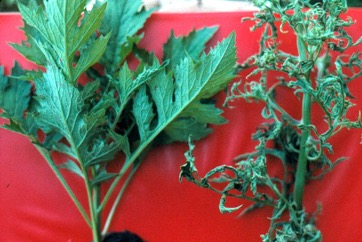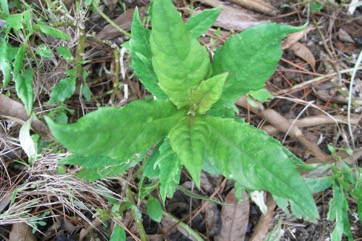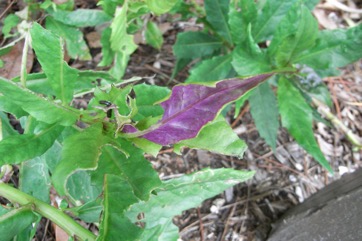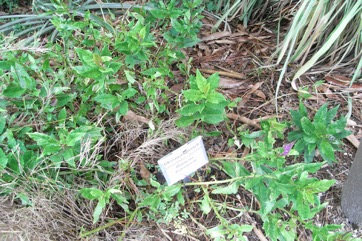Thickhead, Okinawan spinach

A tropical plant. A common weed in Papua New Guinea from sea level to over 2500 m. It is more common in wet areas and in garden sites. It also grows in many other tropical countries. It prefers light shade. At ECHO. In Yunnan. In Sichuan.
Also known as:
Agologolo, A ngung, Bab cherdik, Benibanaborogiku, Buar, Chopogon, Dong ma gun, Doyan-doyan, Ebolo, Ekinami, Fau lele, Gbolo, Gbuluh fuka, Guan dong weu niu, Gyal-pa-ehn,Hogegain, Ibel, Impingi, Ingiri, Kagiji, Limbiti, Lisahuka, Marakapon, Miao kuo, Ming guo cao, Nroj rog, Nya heu bin, O mi o sa, Pakcho, Pan-sout-htoe, Phak kaad chang, Phakkoat chaang, Rau tau bay, Sandeko, Sapsapon, Sipinis, Sla ialieh, Spinat, Tamkahru, Thangbang, Udu daya, Voi ngoai, Wondally, Ya ge la, Yamen, Yaxiehuo
Synonyms
- Crassocephalum crepidioides var. lutea Steen.
- Crassocephalum crepidioides f. luteum (Steen.) Belcher
- Gynura crepidioides Benth.
- Gynura diversifolia Sch.Bip. ex Asch.
- Gynura microcephala Vatke
- Gynura polycephala Benth.
- Senecio crepidioides (Benth.)
Edible Portion
- Leaves, Tubers, Root, Vegetable, Flowers
Where does Thickhead grow?
Found in: Africa, American Samoa, Angola, Asia, Australia, Benin, Brazil, Cambodia, Cameroon, Central Africa, Central African Republic, CAR, Central America, China, Congo DR, Côte d'Ivoire, Dominican Republic, East Africa, East Timor, Eswatini, Ethiopia, Fiji, FSM, Gabon, Gambia, Ghana, Guinea, Guinée, Guinea-Bissau, Hawaii, Himalayas, India, Indochina, Ivory Coast, Japan, Kenya, Korea, Laos, Liberia, Madagascar, Malawi, Marquesas, Mauritius, Mozambique, Myanmar, Niger, Nigeria, Norfolk Island, North America, Northeastern India, Pacific, Papua New Guinea, PNG, Philippines, Pohnpei, Rotuma, Samoa, Sao Tome and Principe, SE Asia, Senegal, Sierra Leone, South Africa, Southern Africa, Sri Lanka, Sudan, Swaziland, Taiwan, Tanzania, Tibet, Timor-Leste, Thailand, Tonga, Uganda, United States, Vanuatu, Vietnam, Wallis & Futuna, West Africa, West Indies, Zambia, Zimbabwe
Notes: There are about 25-30 Crassocephalum species. C. crepidioides contains the hepatotoxic and tumorigenic pyrrolizidine alkaloid, jacobine.
Status: It is a commercially cultivated vegetable. It is used as a wild and cultivated vegetable in Australia, Vietnam, and West Africa. Leaves are sold in local markets.
Growing Thickhead, Okinawan spinach
Cultivation: It grows from seed. It is self sown. Seedlings appear in about 9 days and can be transplanted when 8-12 cm high. A spacing of 25 cm by 25 cm is suitable. Plants are topped when 20 cm high to increase branching. To collect seed, the entire bundle is pulled from the receptacle with one hand, and the hairs removed with the other hand, without letting them mix with the seed.
Edible Uses: The young leaves are eaten cooked as a vegetable. They have a sharp but not bitter taste. They are often eaten mixed with other foods. The leaves are blanched if used in salads. The flowers can be steamed and eaten. The leaves have a smell which does not disappear with cooking. The roots are eaten with chilli sauce or cooked in fish curry. They are also stir-fried. Caution: It contains some alkaloids that are possible toxic. It should possibly not be eaten by pregnant women.
Production: The first leaf harvest can be made in 6-7 weeks. There can be 5-9 harvests over a 60 day period. Seed can be collected for sowing about 16 weeks after sowing.
Nutrition Info
per 100g edible portion| Edible Part | Energy (kcal) | Protein (g) | Iron (mg) | Vitamin A (ug) | Vitamin c (mg) | Zinc (mg) | % Water |
|---|---|---|---|---|---|---|---|
| Leaves | 18 | 2.5 | - | - | 10 | - | 93.1 |
Thickhead, Okinawan spinach Photos




References
Abbiw, D.K., 1990, Useful Plants of Ghana. West African uses of wild and cultivated plants. Intermediate Technology Publications and the Royal Botanic Gardens, Kew. p 41
Achigan-Dako, E, et al (Eds), 2009, Catalogue of Traditional Vegetables in Benin. International Foundation for Science.
Agea, J. G., et al 2011, Wild and Semi-wild Food Plants of Bunyoro-Kitara Kingdom of Uganda: etc. Environmental Research Journal 5(2) 74-86
Altschul, S.V.R., 1973, Drugs and Foods from Little-known Plants. Notes in Harvard University Herbaria. Harvard Univ. Press. Massachusetts. no. 5028
Ambasta, S.P. (Ed.), 2000, The Useful Plants of India. CSIR India. p 253 (As Gynura crepidioides)
Aryal, K., Moe, A.T., Hein, P.P., Bay, Y.H.S., Htay, T., Aung, H.W., Shakya, B., Xuefei, Y., Shaoliang, Y. , 2020, Wild and non- cultivated edible plants and their contribution to local livelihoods in Putao, Myanmar. ICIMOD.
Borrell, O.W., 1989, An Annotated Checklist of the Flora of Kairiru Island, New Guinea. Marcellin College, Victoria Australia. p 63
Burkill, H. M., 1985, The useful plants of west tropical Africa, Vol. 1. Kew.
Cao, Y., et al, 2020, Ethnobotanical study on wild edible plants used by three trans-boundary ethnic groups in Jiangcheng County, Pu’er, Southwest China. Journal of Ethnobiology and Ethnomedicine (2020) 16:66
Chen, B. & Qiu, Z., Consumer's Attitudes towards Edible Wild Plants, Ishikawa Prefecture, Japan. p 23 www.hindawi.com/journals/ijfr/aip/872413.pdf
Cooper, W. and Cooper, W., 2004, Fruits of the Australian Tropical Rainforest. Nokomis Editions, Victoria, Australia. p 80
Cowie, I, 2006, A Survey of Flora and vegetation of the proposed Jaco-Tutuala-Lore National Park. Timor-Lests (East Timor) www.territorystories.nt/gov.au p 43
Dalziel, J. M., 1937, The Useful plants of west tropical Africa. Crown Agents for the Colonies London.
Delang, C. O., 2007, Ecological Succession of Usable Plants in an Eleven-Year Fallow Cycle in North Lao P.D.R., Ethnobotany Research and Applications. Vol. 5:331-350
Denton, O.A., 2004. Crassocephalum crepidioides (Benth.) S.Moore. [Internet] Record from Protabase. Grubben, G.J.H. & Denton, O.A. (Editors). PROTA (Plant Resources of Tropical Africa), Wageningen, Netherlands. < http://database.prota.org/search.htm>. Accessed 15 October 2009.
Eiadthong, W., et al, 2010, Management of the Emerald Triangle Protected Forests Complex. Botanical Consultant Technical Report. p 47
Epenhuijsen C.W. van., 1974, Growing Native vegetables in Nigeria. FAO Rome, p 60
Ethnobotany of Karen in Khun Tuen Noi Chiang Mai. http://khuntuennoi.myspecies
Facciola, S., 1998, Cornucopia 2: a Source Book of Edible Plants. Kampong Publications, p 37
Flora of Australia Volume 49, Oceanic Islands 1, Australian Government Publishing Service, Canberra. (1994) p 397
Fowler, D. G., 2007, Zambian Plants: Their Vernacular Names and Uses. Kew. p 76
Franklin, J., Keppel, G., & Whistler, W., 2008, The vegetation and flora of Lakeba, Nayau and Aiwa Islands, Central Lau Group, Fiji. Micronesica 40(1/2): 169–225, 2008
French, B.R., 1986, Food Plants of Papua New Guinea, A Compendium. Asia Pacific Science Foundation p 337
Fu, Yongneng, et al, 2003, Relocating Plants from Swidden Fallows to Gardens in Southwestern China. Economic Botany, 57(3): 389-402
Ghorbani, A., et al, 2012, A comparison of the wild food plant use knowledge of ethnic minorities in Naban River Watershed Nature Reserve, Yunnan, SW China. Journal of Ethnobiology and Ethnomedicine; 8:17
Godfrey, J. et al, 2013, Harvesting, preparationand preservation of commonly consumed wild and semi-wild food plants in Bunyoro-Kitara Kingdom, Uganda. Int. J. Med. Arom. Plants. Vol.3 No.2 pp 262-282
Goode, P., 1989, Edible Plants of Uganda. FAO p 39
Grivetti, L. E., 1980, Agricultural development: present and potential role of edible wild plants. Part 2: Sub-Saharan Africa, Report to the Department of State Agency for International Development. p 42
Grubben, G. J. H. and Denton, O. A. (eds), 2004, Plant Resources of Tropical Africa 2. Vegetables. PROTA, Wageningen, Netherlands. p 226
Henty, E.E., & Pritchard, G.S., 1973, Weeds of New Guinea and their control. Botany Bulletin No 7, Division of Botany, Lae, PNG. p 70
Hoare, A., 2003, Food use of the Lundayeh SW Sabah. Borneo Research Council.
Hu, Shiu-ying, 2005, Food Plants of China. The Chinese University Press. p 726
IUCN (2013). Ecological Survey of the Mekong River between Louangphabang and Vientiane Cities, Lao PDR, 2011-2012. Vientiane, Lao PDR: IUCN. 241 pp.
Jackes, B.R., 2001, Plants of the Tropics. Rainforest to Heath. An Identification Guide. James Cook University. p 43
Jacquat, C., 1990, Plants from the Markets of Thailand. D.K. Book House p 90
Jardin, C., 1970, List of Foods Used In Africa, FAO Nutrition Information Document Series No 2.p 70
J. Bot. 50:211. 1912
Kays, S. J., and Dias, J. C. S., 1995, Common Names of Commercially Cultivated Vegetables of the World in 15 languages. Economic Botany, Vol. 49, No. 2, pp. 115-152
Khodram,S. D., et al, 2019, Local knowledge of edible flowers used in Mizoram. Indian Journal of Traditional Knowledge Vol 18(40 pp 715-723
Kuo, W. H. J., (Ed.) Taiwan's Ethnobotanical Database (1900-2000), http://tk.agron.ntu.edu.tw/ethnobot/DB1.htm
Latham, P., 2004, Useful Plants of Bas-Congo province. Salvation Army & DFID p 257
Lazarides, M. & Hince, B., 1993, Handbook of Economic Plants of Australia, CSIRO. p 66
Li, S., et al, 2020, Monpa, memory, and change: an ethnobotanical study of plant use in Mêdog County, South-east Tibet, China. Journal of Ethnobiology and Ethnomedicine. (2020) 16:5 p 17
Liu, Yi-tao, & Long, Chun-Lin, 2002, Studies on Edible Flowers Consumed by Ethnic Groups in Yunnan. Acta Botanica Yunnanica. 24(1):41-56
Long, C., 2005, Swaziland's Flora - siSwati names and Uses http://www.sntc.org.sz/flora/
Luczaj, L., et al, 2021, Wild food plants and fungi sold in the markets of Luang Prabang, Lao PDR. Journal of Ethnobiology and Ethnomedicine (2021) 17:6
Luo, B., et al, 2019, Wild edible plants collected by Hani from terraced rice paddy agroecosystem in Honghe Prefecture, Yunnan, China. Journal of Ethnobiology and Ethnomedicine 15:56
Low, T., 1991, Wild Herbs of Australia and New Zealand. Angus & Robertson. p 94 (Drawing)
Low, T., 1992, Bush Tucker. Australia’s Wild Food Harvest. Angus & Robertson. p 155
Lungphi, P., Wangpan, T. & Tangjang, S., 2018, Wild edible plants and their additional uses by the Tangsa community living in the Changlang district of Arunachal Pradesh, India. Pleione 12(2): 151 - 164. 2018.
Maghirang, R. G., et al, 2018. Ethnobotanical Studies of Some Plants Commonly Used as Vegetables in Selected Provinces of the Philippines. Journal of Nature Studies. 17(2), 30-43.
Manvell, A., 2011, Use of Non-Timber Forest Products around Sapo National Park, Liberia (Report B) p 19
Martin, F.W. & Ruberte, R.M., 1979, Edible Leaves of the Tropics. Antillian College Press, Mayaguez, Puerto Rico. p 184
Medhi, P. & Borthakur, S. K., 2012, Phytoresources from North Cachur Hills of Assam -3: Edible plants sold at Hflong market. Indian Journal or Natural Products and Resources. 3(1) pp 84-109
Medhi, P. & Borthakur, S. K., 2013, Wild edible plants sold by the Zeme Nagas at the makeshift market of Mahur, Dima Hasao district of Assam. Pleione 7(1): 84 - 93. 2013
Medhi, P., Sarma, A and Borthakur, S. K., 2014, Wild edible plants from the Dima Hasao district of Assam, India. Pleione 8(1): 133-148
Menisa, A. A., et al, 2012, Survey and characterization of Indigenous Food Plants in Ilocos Norte, Philippines. SEARCA Discussion Paper series No. 2011-2
Mot So Rau Dai an Duoc O Vietnam. Wild edible Vegetables. Ha Noi 1994, p 80
Murtem, G. & Chaudhrey, P., 2016, An ethnobotanical note on wild edible plants of Upper Eastern Himalaya, India. Brazilian Journal of Biological Sciences, 2016, v. 3, no. 5, p. 63-81
Namsa, et al, 2011, Ethnobotany of the Monpa ethnic group ay Arunachal Pradesh, India. Journal of Ethnobiology and Ethnomedicine 7:31 (As Gynura crepidioides)
Ng, X. N., et al, 2012, Nutritional profile and antioxidative properties of selected tropical vegetables. International Food Research Journal 19(4): 1487-1496
Ogle, B. M., et al, 2003, Food, Feed or Medicine: The Multiple Functions of Edible Wild Plants in Vietnam. Economic Botany 57(1): 103-117 (As Gynura crepioides)
Okigbo, B.N., Vegetables in Tropical Africa, in Opena, R.T. & Kyomo, M.L., 1990, Vegetable Research and development in SADCC countries. Asian Vegetable Research and development Centre. Taiwan. p 38
Peters, C. R., O'Brien, E. M., and Drummond, R.B., 1992, Edible Wild plants of Sub-saharan Africa. Kew. p 89
Phawa, G. M., Dkhar, E. K. & Marbaniang, D., 2019, Indigenous Wild Edible Plants of Bataw Village, East Jaintia Hills District, Meghalaya. International Journal of Arts, Science and Humanities. 7(2)
Rao, R.R. & Neogi, B., 1980, Observation on the Ethnobotany of the Khasi and Garo tribes in Meghalaya (India). J. Econ. Tax. Bot. Vol. 1 pp 157-162
Sang, D. T., & Mizoue, K. O. N., 2012, Use of Edible Forest Plants among Indigenous Ethnic Minorities in Cat Tien Biosphere Reserve, Vietnam. Asian Journal of Biodiversity Vol. 3 (1), p 23-49
Segnon, A. C. & Achigan-Dako, E. G., 2014, Comparative analysis of diversity and utilization of edible plants in arid and semi-arid areas in Benin. Journal of Ethnobiology and Ethnomedicine 2014, 10:80
Srivastava, R. C., 2009, Traditional knowledge of Adi tribe of Arunachal Pradesh on plants. Indian Journal of Traditional Knowledge. 8(2): 146-153
Srivastava, R. C., et al, 2010, Indigenous biodiversity of Apatani plateau: Learning on biolcultural knowledge of Apani tribe of Qrunachal Pradesh for sustainable livelihoods. Indian Journal of Traditional Knowledge 9(3): 432-442
Swaziland's Flora Database http://www.sntc.org.sz/flora
Tanaka, Y. & Van Ke, N., 2007, Edible Wild Plants of Vietnam: The bountiful garden. Orchid books. p 49 (As Gynura crepidioides)
Taram, M., et al, 2018, Wild Food Plant Resources of Komkar Adi Tribe of Upper Siang District in Arunachal Pradesh, India. Bulletin of Arunachal Forest Research, Vol. 33(2), 27-35
Teron, R. & Borthakur, S. K., 2016, Edible Medicines: An Exploration of Medicinal Plants in Dietary Practices of Karbi Tribal Population of Assam, Northeast India. In Mondal, N. & Sen, J.(Ed.) Nutrition and Health among tribal populations of India. p 149
Termote, C., et al, 2011, Eating from the wild: Turumbu, Mbole and Bali traditional knowledge of non-cultivated edible plants, District Tshopo, DRCongo, Gen Resourc Crop Evol. 58:585-618
Termote, C., 2012, Wild edible plant use in Tshopo District, Democratic Republic of Congo. Universiteit Gent. p 70
Terra, G.J.A., 1973, Tropical Vegetables. Communication 54e Royal Tropical Institute, Amsterdam, p 41
Tomimori, K., et al, 2012, Antitumor activity and macrophage nitric acid producing action of medicinal herb, Crassocephalum crepidioides. BMC Complementary and Alternative Medicine. 12:78
Tsering, J., et al, 2017, Ethnobotanical appraisal on wild edible plants used by the Monpa community of Arunchal Pradesh. Indian Journal of Traditional Knowledge. Vol 16(4), October 2017, pp 626-637
Van Sam, H. et al, 2008, Uses and Conservation of Plant Species in a National Park. A case study of Ben En, Vietnam. Economic Botany 62:574-593 (As Gynura crepidioides)
Wang, J. et al, 2013, A Study on the Utilization of Wild Plants for Food in Liangshan Yi Autonomous Prefecture. Plant Diversity and Resources. 35(4): 416-471
Whitney, C. W., et al, 2014, Conservation and Ethnobotanical Knowledge of a Hmong Community in Long Lan, Luang Prabang, Lao People’s Democratic Republic. Ethnobotany Research and Applications 12:643-658
World Checklist of Useful Plant Species 2020. Royal Botanic Gardens, Kew
Xu, You-Kai, et al, 2004, Wild Vegetable Resources and Market Survey in Xishuangbanna, Southwest China. Economic Botany. 58(4): 647-667.
Zon, A.P.M. van der, Grubben, G.J.H., 1976, Les legumes-feuilles spontanes et cultives du Sud-Dahomey, Communication 65, Royal Tropical Institute, Amsterdam, p 54